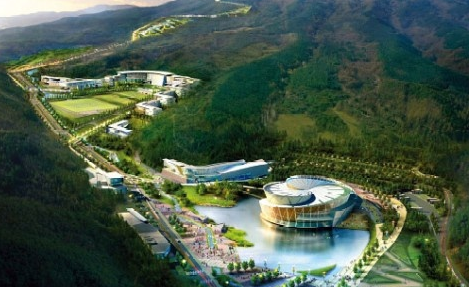What does beautiful Millennium Park in Abuja, Nigeria have to do with Italy?
The Internet can be a mind-numbing rabbit hole but sometimes it yields some genuine nuggets.
It started with an old YouTube clip I saw of the Black conservative Thomas Sowell (still alive at age 90, btw). He mentioned that the Igbo tribe in Nigeria was one of the first to embrace the allegedly “racist” colonial practice of mass education, which eventually gave them an advantage over various other ethnic tribes in that nation.
I wasn’t sure if this was on the level, though I do recall an ex-high school student of mine, whose parents were first-generation immigrants from Nigeria, telling me about the various class systems there.
Incidentally, this student didn’t view his country’s class system as something racist or oppressive “inherited” from the British. He said it’s a reflection of human nature, and that the push for education – whether from within a family, a culture or an individual’s own self-image – is what often helps people rise above their circumstances.
(Note: His younger brother was hired as the chief public relations officer with the Chicago Bulls NBA franchise – a very high-profile media job with a pay scale to match. Not bad for a student whose parents still speak with African accents.)
While looking up Nigeria on the ‘Net, I saw that there was a “Millennium Park” in the city of Abuja. That is also the name of a recent (2006) park built in my home city of Chicago, hence my stopping to read up on it. I soon discovered that it was built by an Italian architect unknown to me but probably known to the Italians: Manfredo Nicoletti (1930-2017).

Turns out Nicoletti, like many Italians before him, didn’t limit his talents to his home nation, though he certainly blessed them with it. He also worked on many projects worldwide, extending that “fine Italian hand” around all of Planet Earth.
In addition to his made-in-Italy achievements (e.g., airports in Sicily; a meeting room at the Italian Parliament in Rome; a courthouse in Lecce; and a university campus in Udine), Nicoletti built concert halls in Kazakstan and Malaysia as well as a skyscraper in New York. But wasn’t it ever thus in the field of architecture?
In modern times, Renzo Piano built not only the famous aquarium in his home city of Genoa but structures in Paris (the Centre Georges Pompidou), London (The Shard), New York (the Whitney Museum of American Art), Chicago (the new wing of the Art Institute), Turkey (the Istanbul Modern), and Greece (Stavros Niarchos Foundation Cultural Center).
During the Renaissance/Rinascimento, you couldn’t walk three feet without bumping into architectural masters such as Michelozzo (born Michelozzo di Bartolomeo Michelozzi), Filippo Brunelleschi (the dome of Santa Maria dei Fiore in Florence), Andrea Palladio (whose classical buildings inspired Thomas Jefferson’s Monticello), and Leon Battisti Alberti.
The ideas and designs of these geniuses spread far and wide, even if they didn’t.
Ones who certainly did were the parade of Italian architects hired by rulers of Russia (Peter and Catherine) to transform their nation’s architecture. That they did, building everything from the walls of the Kremlin to the Hermitage Museum in St. Petersburg.
That tradition continues to this day: Architect Michele de Lucchi built the famous “Bridge of Peace” in Tbilisi (Russian Georgia) in 2010, while another, Lanfranco Cirillo, built the infamous “Putin Palace” near the city of Gelendzhik.
(Note: Issue XL, 2014 of The Italic Way Magazine profiled the numerous architects who historically beautified Russia:
https://italic.org/wp-content/ResearchLibrary/ItalicWay/Editions/ItalicWay2015XL.pdf)
And let’s not forget that an Italic woman, the late Gae (Gaetana) Aulenti, also shared her designing talents with other nations, whether in France (the main gallery of the Musee d’Orsay) or Spain (the National Museum of Catalunya Art in Barcelona). Ms. Aulenti likewise restored the historic Venetian opera house La Fenice after a devastating fire in 1996.
The same sharing spirit is shared by American architects of Italian heritage. The most notable, of course, is Robert Venturi, whose works literally spread from coast-to-coast, from Philadelphia to La Jolla, California. If you visit Japan’s Nikko National Park, you will see the Nikko Kirifuri Resort (his). Ditto the Provincial Capital Building in Toulouse, France.
Whether it’s the builders of the Pantheon of classical Rome or the immigrants who literally built America (subways, skyscrapers, school buildings, railroads, etc.), the Italians used their hands for more than just amusing or expressive gestures. Please notice that the first part of the word architecture is “arch” (as in arches/aqueducts).
And though I may be damned for saying this, this gift has to be somewhat genetic.
Years ago, I interviewed an Italian-born scientist at Fermilab in Illinois who tried to explain the inner-workings of a brand-new atomizer the lab was building. Despite his best verbal attempts, my confused face must have given me away. He stopped, smiled, put his finger up in the air (as if to say, “hold on”), then grabbed an empty napkin sitting near his cup of coffee. He preceded to visually sketch the various gears, pistons, slabs, etc. Then it all made sense.
If you build anything – be it a machine, an ice-cream cone, or a magnificent structure that lives for the ages – make sure someone with Italian blood is put in charge. The results are there to see and enjoy in every part of the world. -BDC

Recent Comments